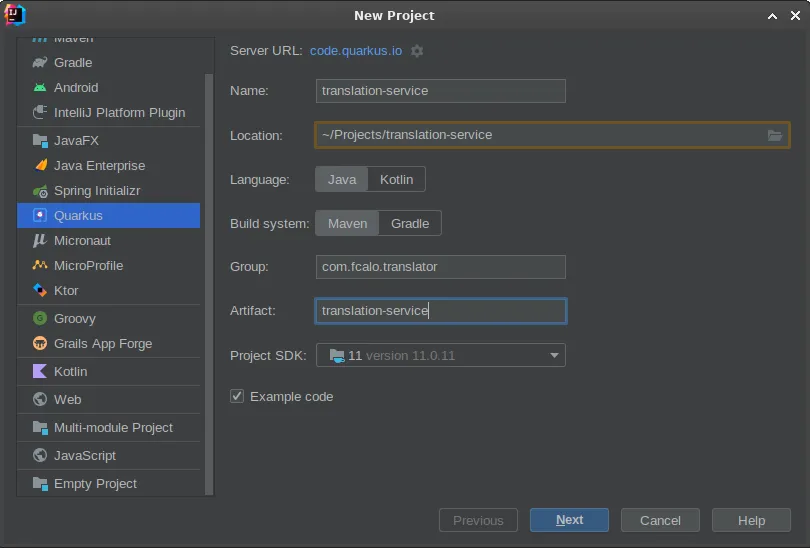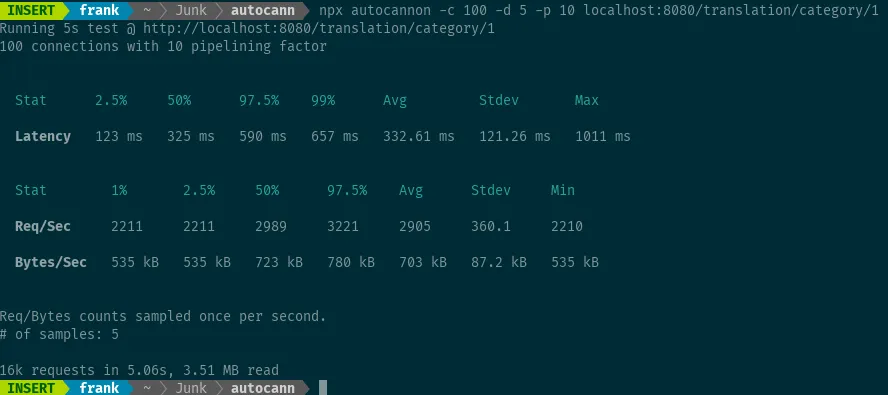From open-jdk to quarkus
Feb 26, 2022
Why I am writing this…
I’ve been developing in java a lot more then I expected some months ago,
the project I’ve worked on lately is a micro-service architecture app,
with a lot Java8/11 services,
which get deployed in containers with open-jdk as the base image.
The main problems the team had to face in this scenario was about performance caused by the jre inside a docker container.
When Java came out around 1995 one of its selling points was
“write once, run everywhere”,
the JVM was built with that goal in mind, giving a portable environment to the program,
and this is certainly one of the key factors of Java’s success.
Nowadays, the defacto standard for solving the portability issue are containers.
Leveraging Linux namespaces/kernel, it is possible to pack the program, runtime and dependencies, in an efficient and easy to consume format.
There are many factors which have brought containers to become the most popular unit of work when building custom micro-services: devOps practices, small footprint, Linux overtaking the server world, etc.;
these are some of the reasons it is one of the most important blocks in CNCF landscape.
The issue
The original JVM and containers overlap in scope, and due to the legacy structure of open-jdk, it doesn’t fit well inside a container.
This problem fortunately has already been addressed by RedHat,
The solution is Quarkus, a container first Java runtime.
So to demo how Qaurkus works I’ll develop something…
What we’ll build is a REST micro-service that will provide translation functionalities to consuming services.
The service can host multiple dictionaries, a given translation is placed in a dictionary, a dictionary may contain many translations.

We’ll touch the following topics along the way:
- Basic scaffolding
- Testing and debugging
- Data layer integration/migrations
- Packaging
Basic scaffolding
This is quite easy, Quarkus has been built from the ground with the primary focus of providing a delightful developer experience.
For convenience I’ll use Intellij, but there is also a cli and tools for other IDEs as well.
In the Intellij panel we start up a project with Qaurkus and Java11 as runtime, as for the dependency I’ve included only “Reactive Routes” and “RESTEasy Jackson” to start:

Our pom’s dependencies now includes quarkus-resteasy, quarkus-resteasy-jackson, quarkus-reactive-routes, quarkus-arc, quarkus-junit5, rest-assured,
Launch mvn quarkus:dev and you have a running hot reload environment ready to go at localhost:8080.
During configuration I selected code example so I also get a preconfigured GET endpoint at /hello.
But this is not reactive!! Let’s refactor the ExampleResource class to TranslatorCtrl and change the file content to:
@ApplicationScoped
public class TranslatorCtrl {
@Route(path = "hello")
public String hello() {
return "hello";
}
@Route(methods = Route.HttpMethod.GET, path = "hello-through-ctx")
public void hello(RoutingContext rc) {
rc.response().end("hello twice");
}
@Route(methods = Route.HttpMethod.GET, path = "hello-through-exchange")
public void hello(RoutingExchange ex) {
var paramName = ex.getParam("name").orElse("Stranger");
ex.ok("hello, this looks lots like express.js, paramName is " + paramName);
}
}This is quite basic.
I’ll refactor the class containing our ExampleController to TranslatorCtrl, so also test references will be affected.
Testing and debugging
In our scaffolding we already have some testing facilities, lets put them to work.
Running TranslatorCtrlTest you’ll see it fail, and in TDD, having the first test to fail, is the first step towards quality software XD;
anyway, this is and easy fix, change the return to hello and the test will pass.
In the testing folder you’ll also notice another class, NativeTranslatorCtrlIT, this is used to run tests with the native build, we won’t use it for now.
Debugging is a big part of any efficient development environment.
With Intellij this is as easy as attaching a debugger to the running process.
Pressing the shortcut CTR-ALT-5 will bring up a modal to do that, choose the correct process, and you’re done;
if you now set a breakpoint in the hello method and call that route you’ll have a working debug context.
You can find the code up to this point at this specific commit.
Data layer integration/migrations
Now we should start to persist something to the db, for this we’ll run a postgres db locally using a container,
I’ll also run adminer db client for interacting with the db directly (in case you need it’s localhost:8888),
The repo contains a docker-compose with all pieces in the right place,
with docker-compose up -d you’re up.
To access the db we’ll need to add quarkus-hibernate-orm and quarkus-jdbc-postgresql as dependencies,
I’ve chose to use hibernated directly but you could also implement the active-directory pattern with panache.
In order to make this work we create the entities with all the proper hibernate annotations,
these are quite intuitive, below you can find the heading of the TranslationCategory entity.
@Entity
@Getter
@Setter
@NamedQuery(name = "TranslationCategory.findAll", query = "SELECT f FROM TranslationCategory f ", hints = @QueryHint(name = "org.hibernate.cacheable", value = "true"))
@Table(name = "translation_categories")
@Cacheable
public class TranslationCategory {
@SequenceGenerator(name = "translationCatSeq", sequenceName = "translation_cat_id_seq", allocationSize = 1, initialValue = 1)
@GeneratedValue(generator = "translationCatSeq", strategy = GenerationType.AUTO)
@Id
private Long id;
private String name
....
The data-layer integration can be found at this commit,
It’s quite basic, but you’ll probably need to at least take a glimpse to understand what comes next.
To consume our entities I’m calling the entityManger directly in the TranslatorCtrl.
All basic CRUD operations on Translation and TranslationCategories have been implemented.
One issue you might notice is that we’re not using a reactive driver/pattern to access the DB, if I was to place this solution in production this is something I’d look into, not for now…
Packaging
So far we’ve been using the dev environment,
but quarkus’ packaging phase is what it was build for in the first place.
Exploiting Graalvm we’re able to make tiny executables that can be run by a minimal images such as quarkus-micro-image.
In order to have reproducible builds without having to mess with installing graalvm itself we can use a multistage container like the following:
## Stage 1 : build with maven builder image with native capabilities
FROM quay.io/quarkus/ubi-quarkus-native-image:21.3.1-java11 AS build
COPY --chown=quarkus:quarkus mvnw /code/mvnw
COPY --chown=quarkus:quarkus .mvn /code/.mvn
COPY --chown=quarkus:quarkus pom.xml /code/
USER quarkus
WORKDIR /code
RUN ./mvnw -B org.apache.maven.plugins:maven-dependency-plugin:3.1.2:go-offline
COPY src /code/src
RUN ./mvnw package -Pnative
## Stage 2 : create the docker final image
FROM quay.io/quarkus/quarkus-micro-image:1.0
WORKDIR /work/
COPY --from=build /code/target/*-runner /work/application
COPY wait-for-postgres.sh /work/wait-for-postgres.sh
# set up permissions for user `1001`
RUN chmod 775 /work /work/application \
&& chown -R 1001 /work \
&& chmod -R "g+rwX" /work \
&& chown -R 1001:root /work \
&& chmod u+x /work/wait-for-postgres.sh
EXPOSE 8080
USER 1001
CMD ["./application", "-Dquarkus.http.host=0.0.0.0"]To tie the service and db together I’ll add it to the docker-compose. I’ve also changed the database hostname inside the app.properties.
Please note, if you were to implement this solution in production, you probably should also move the sensible configuration into environment variables so to inject them at runtime…
Also note that, due to the way Graalvm works, I’ve added the @RegisterForReflection annotation on the TranslationInDto class, more info on that in the docs.
If we analyze the container size we can see that it has a size of 162MB (docker ps —size),
most interesting launching autocannon test after having loaded some translation this is the output:

Connected to database we are able to serve 16k requests in 5 seconds, I don’t really have experience in this kind of test but is seems quite snappy.
The max memory consumed during the test is around 450MB, and, although I haven’t tried this exact app on the open-jdk, in my experience, similar services would have consumed a lot more.
So this is not a production ready or complete solution, and certainly I’m not the best Java programmer in the world, but what I learned through this demo is that it is quite easy to implement a quarkus solution.
There are multiple benefits from a traditional java JDK app.
IMHO What it all comes down to is that, in a micro-service architecture, using the traditional jre has no future when you have quarkus as an alternative :).